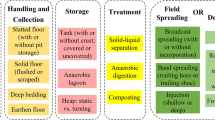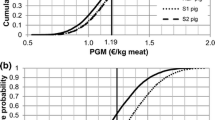Abstract
One of the major contributions to atmospheric pollution comes from nitrogen (N) derived from cattle and especially dairy cows. Although most estimates of ammonia volitilization are based on total N excretion, it has been repeatedly shown that urinary N is a much more important source of pollution than faecal N, specially under grazing conditions. A model was developed to predict the amount and form of N excreted under different production systems. Analysis of N pollution was based on data collected from Holstein/Friesian cows fed 30 different diet types consisting of 10 grass silages and 6 concentrates. While there was a strong correlation between N intake and N output in general, urinary N was exponentially correlated with N intake and the model predicted about 80% loss of N in urine for levels of N consumption above 500 g N/d. On the other hand, outputs of faecal and milk N increased by less than 20% per unit increase in N intake. Model predictions also agreed well with published data and provided reasonable estimates of the form in which N was excreted. Concentrate composition with respect to energy type and its degradation and protein degradability and silage type had significant effects on the amount and form of N excreted. It is concluded that N pollution may be ameliorated by using grass grown with moderate fertiliser application, and maize-based energy supplements, formulated to provide low degradable protein and with N intakes of less than 400 g/d for average yielding cows.
Similar content being viewed by others
References
ApSimon HM, Kruse M & Bell JNB (1987) Ammonia emissions and their role in acid deposition. Atmosph Environ 21(9): 1939–1946
Beever DE (1993) Rumen Function. In: Forbes JM & France J (eds) Quantitative Aspects of Ruminant Digestion and Metabolism. Wallingford: CAB International
Beever DE, Hattan A, Reynolds CK & Cammell SB (2000) Nutrient supply to high-yielding dairy cows. In: Diskin MG (ed) Fertility in the High-Producing Dairy Cow, Occ Publ Br Soc Anim Sci (In press)
Bockmann HC, Lang R, Jensen N, Junge W & Kalm E (1997) Analysis of nitrogen balances from dairy cows. Zuchtungskunde 69: 95–111 (Abstract)
Bruchem JV, Bosch MW & Oosting S (1996) Nitrogen efficiency of grassland-based dairy farming - New perspectives using an integrated approach. In: Groen GE & Bruchem JV (eds) Utilisation of Local Feed Resources by Dairy Cattle, pp 99–101. EAAP Publication No. 84, Wageningen Press
Department of Environment (1996) The Protection of Water against Agricultural Nitrate Pollution (England and Wales) Regulations 1996. London: HMSO
European Centre for Ecotoxicology & Toxicology of Chemicals (1994) Ammonia emissions to air in Western Europe. Technical Report no. 62. Brussels: ECETOC
Genstat 5 Committee (1994) Genstat 5 Release 3 Reference Manual. Oxford: Clarendon Press
Gruber L, Steinwender R & Schauer A (1991) Milk yield and nitrogen balance in dairy cows at different protein levels and constant energy supply. In: Eggum BO, Boisen S. Børsting C, Danfær A, Hvelplund T (eds) Proc. 6th International Symposium on Protein Metabolism and Nutrition, Vol 2, pp 315–317. Foulum: National Institute of Animal Science Research Centre
Huhtanen P (1988) The effects of barley, unmolassed sugar-beet pulp and molasses supplements on organic matter, nitrogen and fibre digestion in the rumen of cattle given a silage diet. Anim Feed Sci Technol 20: 259–278
Keady TWJ, Mayne CS & Marsden M (1998) The effects of concentrate energy source on silage intake and animal performance with lactating dairy cows offered a range of grass silages. Anim Sci 66: 21–33
Kirchgessner M, Windisch W & Kreuzer M (1991) Stickstoffesmission laktierender Milchkühe über die Gülle in Abhängigkeit von der Leistungsintensitat. Agribiol. Res. 44: 1–13
Kirchgessner M, Windisch W & Roth FX (1994) The efficiency of nitrogen conversion in animal nutrition. Nova Acta Leopoldina 70: 393–412
Lockyer DR & Whitehead DC (1990) Volatilization of ammonia from cattle urine applied to grassland. Soil Biol Biochem 22: 1137–1142
MAFF (1999) Agricultural and horticultural census: 1 June, 1988, United Kingdom. York: Government Statistical Service
MAFF Environmental R&D Newsletter (1998) N - and P-plan diets - Better livestock diets for the environment. Autumn 98 issue, 4: 8
MAFF Environment (1994) Organic manures and nitrate leaching. In: Solving the Nitrate Problem - Progress in research and development. MAFF Environment 11–14
Mason VC, (1969) Some observations on the distribution and origin of nitrogen in sheep faeces. J Agric Sci 73: 99–111
Mason (1996) Biology of Freshwater Pollution, 3rd edition. London: Longman
National Rivers Authority (1995a) Water pollution incidents in England and Wales - 1994. Water quality Series No. 25. London: HMSO
National Rivers Authority (1995b) National Rivers Authority: Pollution from Farms in England. London: HMSO
Ørskov ER (1986). Starch digestion and utilisation in ruminants. J Anim Sci 63: 1624
Pakrou N & Dillon P (1995) Preferential flow, nitrogen transformations and 15N balance under urine-affected areas of irrigated and non-irrigated clover-based pastures. J Contam Hydrol 20: 329–347
Petit HV & Tremblay GF (1995) Ruminal fermentation and digestion in lactating cows fed grass silage with protein and energy supplements. J Dairy Sci 78: 342–352
Reynolds CK, Sutton JD & Beever DE (1997) Effects of feeding starch to dairy cattle on nutrient availability and production. In: Garnsworthy PC and Wiseman J (eds) Recent Advances in Animal Nutrition, pp 105–134. Nottingham: Nottingham University Press
Statistical Analysis Systems Institute (1989) SAS/STAT user's guide version 6, 4th edn, Cary: Statistical Analysis Systems Institute
Susmel P, Spanghero M, Stefanon B & Mills CR (1995) Nitrogen balance and partitioning of some nitrogen catabolites in milk and urine of lactating cows. Livest Prod Sci 44: 207–219
Sutton JD, Abdalla AL, Phipps RH, Cammell SB & Humphries DJ (1997) The effect of the replacement of grass silage by increasing proportions of urea-treated whole-crop wheat on food intake and apparent digestibility and milk production by dairy cows. Anim Sci 65: 343–351
Tamminga S (1992) Nutrition management of dairy cows as a contribution to pollution control. J Dairy Sci 75: 345–357
Author information
Authors and Affiliations
Rights and permissions
About this article
Cite this article
Kebreab, E., France, J., Beever, D. et al. Nitrogen pollution by dairy cows and its mitigation by dietary manipulation. Nutrient Cycling in Agroecosystems 60, 275–285 (2001). https://doi.org/10.1023/A:1012668109662
Issue Date:
DOI: https://doi.org/10.1023/A:1012668109662




